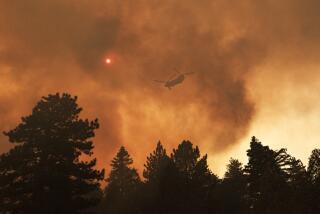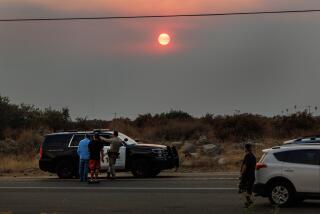Op-Ed: You don’t have to live close to wildfires for them to kill you

For nearly two weeks last November, smoke from the Camp fire drained 150 miles down the Central Valley and out toward the sea, engulfing Sacramento and the whole Bay Area. San Francisco looked — and breathed — like New Delhi, the world’s most polluted city.
Miles away in the mountain town of Paradise, the fast-moving conflagration killed 85 people — making the Camp fire the deadliest wildfire in state history. But pollution research suggests that once heart attacks and respiratory-related deaths are factored in, its soot was even more deadly than its flames.
Based on the results of earlier pollution studies, we project that soot from the Camp fire caused about 100 premature deaths just in the San Francisco Bay Area and hundreds more hospitalizations and emergency room visits than normal. The Central Valley, which was not part of our study, likely suffered similar consequences.
The link between high levels of soot exposure and damage to human health has been recognized since the 1950s. And since the 1990s scientists have known that the most dangerous soot is PM2.5, particulate matter no larger than 2.5 microns across. If inhaled, these microscopic particles can lodge in the lungs and even slip into the bloodstream.
Only preventing megafires can protect the millions of Californians vulnerable to deadly soot.
Quantifying soot’s effects on human health is like tuning a radio to catch a distant station; it takes care to detect soot’s signal amid the noise from other factors. It’s not enough to simply compare daily soot levels with the number of hospitalizations or mortality counts. A host of other variables, such as weather or even the day of the week, have to be accounted for. What’s remarkable is that in time-based epidemiological studies, soot’s damning signal has been found again and again.
Backing them up is another body of research that uses an entirely different approach: comparing death rates in various locations with pollutant concentrations in those areas. Those studies produce even higher estimates of PM2.5’s harms, likely because they capture chronic disease set in motion by daily pollution.
Big wildfires put to shame the regular sources of PM2.5, such as power plants, diesel trucks and wood stoves. The Atlas and Tubbs fires, which killed 31 people in Napa and Sonoma counties in October 2017, produced approximately 50,000 tons of PM2.5. That’s the equivalent of three years’ worth of typical human-caused pollution from the Bay Area.
Data from those 2017 fires show how accurate current pollution health models are. Modeling predicts an additional 25 to 100 deaths in the Bay Area during the 10 consecutive days of high soot levels caused by those fires. Analysis of Bay Area health records (provided by the state’s Office of Environmental Health Hazard Assessment) shows that roughly 105 more people died during the soot spike, compared with the 10 days before and 10 days thereafter.
These figures likely understate the total pollution-related death toll from wildfires because their smoke spreads beyond county boundaries, and health effects may take years to play out.
Turning such epidemiological insight into cogent regulations is never easy, but in the case of PM2.5, the U.S. is at risk of moving in the wrong direction. Under the Trump administration, the EPA appointed a PM2.5 skeptic, Louis Anthony “Tony” Cox Jr., to chair its Clean Air Science Advisory Committee, which is reviewing the nation’s PM2.5 standards.
Cox rejects the scientific consensus that soot is highly dangerous — an opinion far outside the norm. Instead, his studies argue that PM2.5-related mortality is a statistical red herring, confounded by shifting seasons and weather.
Despite the mountain of studies on soot’s harms, at a clean air committee meeting last week, Cox declared himself “appalled” by what he claims is a dearth of direct evidence that PM2.5 causes premature death. He is telling the EPA’s administrator that the agency should not regulate soot without a scientific smoking gun: studies showing that reducing soot saves lives.
Enter the Fray: First takes on the news of the minute from L.A. Times Opinion »
We believe the Atlas-Tubbs fires provide exactly that. During those fires, the Bay Area cooled from 64.7 degrees to an equally comfortable 62.4 F — hardly the kind of seasonal or weather shift capable of elevating death rates as seen in Napa and Sonoma counties. When the smoke cleared, those death rates dropped.
The Camp fire, which produced much higher PM2.5 levels, should provide an even clearer signal. Analysis of health records from before, during and after the fire — which we believe will confirm our projections of 100 or more additional deaths — should be a priority for the state.
This fuller accounting of the death toll from wildfires has important implications for how we go about protecting human lives. Targeting firefighting resources to the wildland-urban interface, for example, may protect front-line communities from the devastation seen in Paradise and Santa Rosa. But only preventing megafires can protect the millions of Californians vulnerable to deadly soot.
Our analysis also suggests that those who start fires — such as Pacific Gas & Electric, which stated last month that its equipment likely sparked the Camp fire — may face greater liability. And it’s a reminder that we all have a lever to fight fire through our personal carbon emissions, which drive the climate change that’s making California hotter and drier and providing a tinderbox for the sparks.
David Fairley was the Bay Area Air Quality Management District’s statistician for 30 years. He produced one of the first studies linking fine soot to daily mortality. Peter Fairley is an environmental journalist.
Follow the Opinion section on Twitter @latimesopinionand Facebook
More to Read
A cure for the common opinion
Get thought-provoking perspectives with our weekly newsletter.
You may occasionally receive promotional content from the Los Angeles Times.










